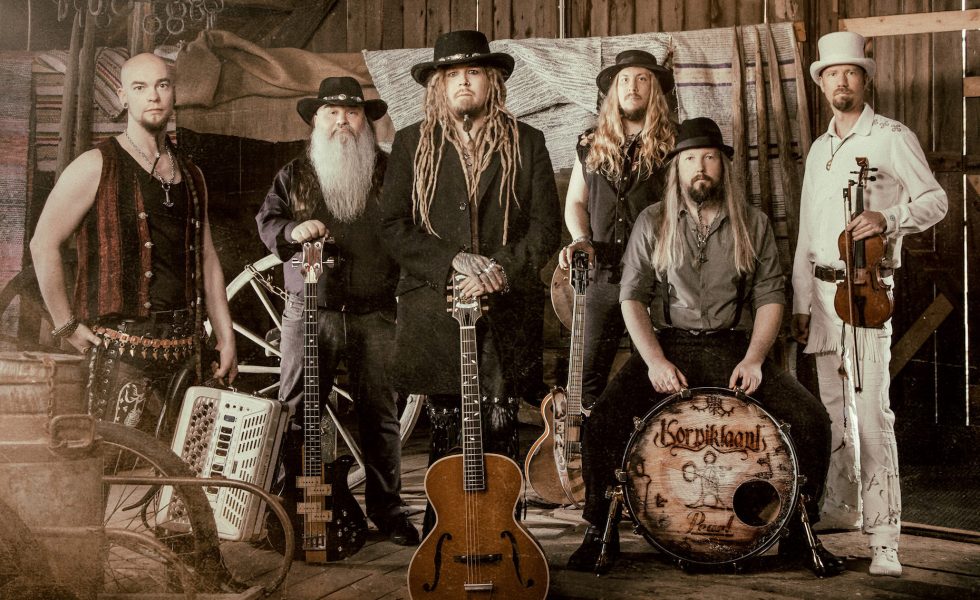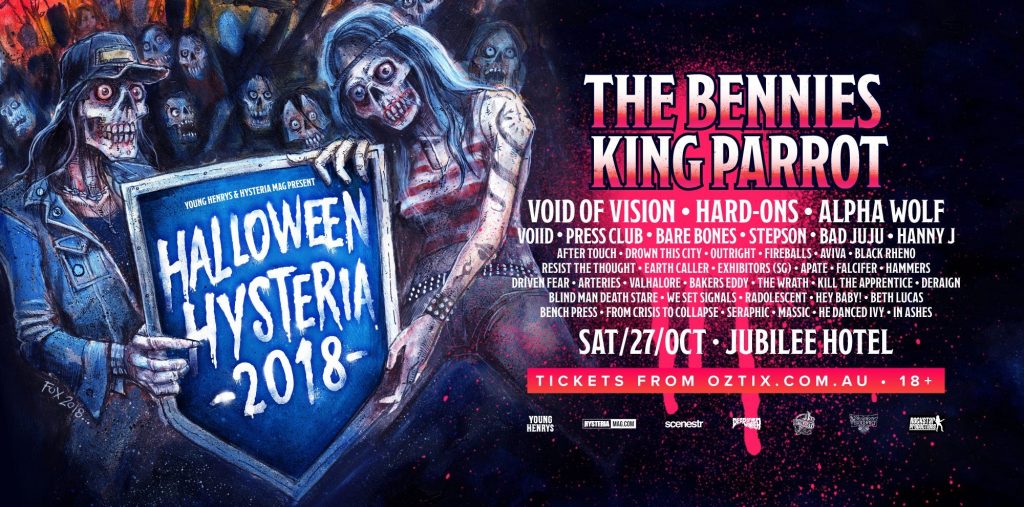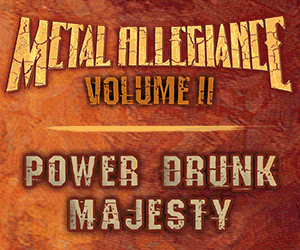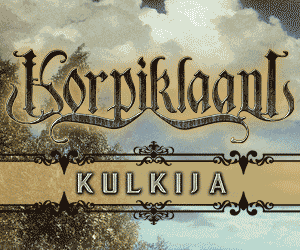Brisbane’s pop-punk upstarts Two Times Shy are soaring lofty heights as they let loose their …
Korpiklaani, the longstanding titans of Finnish folk metal, have after three long years finalised their tenth full-length album Kulkija, or ‘Wanderer’.
MORE: HALLOWEEN HYSTERIA: Your Guide To The Best Gig This October // REVIEW: THRICE: Palms // KORPIKLAANI: Kulkija
Known for their ruthless yet romantic use of Finnish language and folk traditions, Korpiklaani have returned with a megalithic fourteen track album that builds upon their ever evolving quest to bring metal together with their cultural heritage that was last formulated in 2015 with Noita [‘Witch/Shaman’].
“I think in our previous album, the Noita album, we really found a beautiful balance between the folk and the metal,” says violinist Tuomas Rounakari. He talks about how Kulkija continues the work from their last album. On arriving at this elusive balance, Rounakari continues, “and that’s really how Korpiklaani was originally born, that Jonne [Järvelä, vocalist/guitarist] was playing folk music with Shaamani Duo, and then playing metal with his school mates and in other places, and then came the idea to combine these two worlds, so folk and metal, and from the folk side there’s quite a strong Finnish folk tradition that you can hear in our melodies, and especially in our text and lyrics, as Finland has one of the largest, well actually the largest, archive of poetry and all of those hundred of thousands of poems are actually lyrics to songs, so every poem was sung in our tradition.
“So that’s like the folk aspect, but for a very long time the balance, how to balance out the folk elements and metal elements, how to merge those two, its been a journey, a learning process, and Noita – our ninth album – was the first one when we really felt, as a band, that now the balance is ready, now it’s perfect. It’s something Jonne had been looking for all these years and now with Kulkija we are actually going in even a step further, we have a new producer for this album [Janne Saksa] and working with him was really effortless, and somehow this effortless feeling is in the Kulkija album as well, there are a lot of first takes, most of the vocals and violin solos are first takes, and so now the balance we found … is also in the way we play, the violin and accordion play in a much more ‘folky’ way, like the interpretation of the melodies is more ‘folk’ that it was ever before, and also by taking the first takes of the vocal tracks, there’s a lot of natural, organic, loose feeling to it, which again, brings the folks style and folk way of doing music into a more prominent role. So, that’s the continuation.”
Because it’s a long album, fourteen songs, and seventy one minutes, and its about a Wanderer, so what I would really love is if our fans take the time to go on a journey to take the time to listen, to live that album from the first track to the last one.
[TUOMAS]
On capturing this natural feeling, Kulkija was recorded with the same set up as the tour rig? It was recorded how it was intended to be played live.
“… I’m glad you say that, because we share that feeling, in our live shows we have very uplifting energy, and with this album you can sense the same energy, the same uplifting energy that we have in our live shows. And that’s something that makes this album special too.”
Kulkija takes the listener through some profound themes. It features the Wanderer at various stages of his life journey, embracing the tensions between the home and the road, the yearning for movement and the desire for belonging, the haunting and the merry… “Yeah that’s absolutely right,” Rounakari explains, “in a way I could say that the album is the world seen and experienced with wanderer’s eyes. And of course its not that far fetched an idea for us, as we spend about a hundred and fifty days on the road per year [laughs]. For the wanderer, there’s this attitude to life, where the road is your home, and adventure is a way of being. But there’s also the down side of it, and the harsh feelings, and Riemu [track 11] is a perfect example of that because it is such a joyous chorus, such a joyous song about going to a party, but then its diversifies, there’s this grunting part that is really surprising and contrasting through the chorus and there the Wanderer is doubting his sanity, how to hold yourself together when you don’t have a centre point in life anywhere and you know, sometimes you know you feel like you’re losing your mind because of that. In that song those two polarities are presented.”
Certainly, the tracks on Kulkija present a vibrant range of imagery and seemingly metaphorical references, such as blazing and horned eyes invoked in the song Kallon malja [‘Chalice of the Skull’]. “That’s an interesting song,” Rounakari pauses a moment, perhaps sensing that a deeper explanation is needed. “It’s nine minutes long, maybe close to ten minutes even, and it’s the longest song we’ve ever done, and in that song to me, the wanderer in something closer to a survivalist.
“When you think of the Finnish landscape, that’s a big part of being a wanderer, surviving out there. Surviving in harsh conditions and surviving with wolves mainly, wolves would be our main predator in our ecosystem. So, there’s actually section in that song that describes running with wolves, or wolves running, and all of these things relate to the animal instincts of the man. And the mythical layers and that can be found respecting the animal that we are as human beings, and sort of twisting with those layers of reality and a lot of symbolism are traditional symbols of this shift of consciousness, the shift of layers in our human and animal psyche.”
Korpiklaani have certainly tapped into some of the very primal, powerful aspects of Finnish folklore on Kulkija, which leaves one wondering how they have interpreted this musically. Rounakari is more than happy to explain: “Jonne is very talented in mimicking the traditional folk style. Like, there are some songs he has written that when I heard of them I was thinking that ‘this a folk song melody from Southern Ostrobothnia district [in Finland]’ so his style of writing is so similar to our folk traditions at times, not always, but at times, you could easily mistake them for something traditional. And in this album I think it’s the last song, Tuttu on tie [‘The Road Is Familiar’] is a good example of such a song, that violin line and that melody line are a very typical Finnish melody but it’s a new song. So, he is really gifted in writing in the style of tradition, writing new songs in the style of the Finnish. But in Harmaja [‘The Grey’] that’s really not that traditional as a Finnish folk song but really sounds like Jonne, Jonne’s melancholic style of writing, and then again in Kallon malja, that was mentioned, that has a lot of traditional feel again, But definitely this haunting, or beautiful melodic violin lines, are very traditional, very much part of the traditional music in Finland.”e
Kulkija is a richly endowed album, echoing powerful messages from the past yet recounting a relatable tale, and Rounakari is certain that it is best embraced as a whole. Finally, he invites the listeners to enter the Korpiklaani realm, “Because it’s a long album, fourteen songs, and seventy one minutes, and its about a Wanderer, so what I would really love is if our fans take the time to go on a journey to take the time to listen, to live that album from the first track to the last one.”







